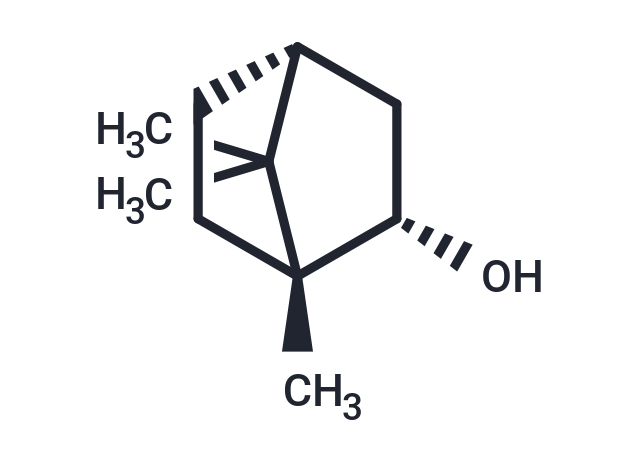Shopping Cart
- Remove All
 Your shopping cart is currently empty
Your shopping cart is currently empty

(+)-BORNEOL (d-Borneol) is a natural bicyclic monoterpene used for analgesia and anesthesia in traditional Chinese medicine; enhances GABA receptor activity with an EC50 of 248 μM.

| Pack Size | Price | Availability | Quantity |
|---|---|---|---|
| 50 mg | $50 | In Stock | |
| 1 mL x 10 mM (in DMSO) | $50 | In Stock |
| Description | (+)-BORNEOL (d-Borneol) is a natural bicyclic monoterpene used for analgesia and anesthesia in traditional Chinese medicine; enhances GABA receptor activity with an EC50 of 248 μM. |
| Targets&IC50 | GABA:248 μM(EC50) |
| In vitro | Aβ-induced cell cytotoxicity was inhibited by 100 μM of (-) and (+) borneol treatment. Treatment of borneol significantly decreased ROS generation (P < 0.01). The expression of HO-1 and nuclear translocation of Nrf2 were increased by Aβ treatment. This nuclear translocation of Nrf2 was further increased by administration of borneol. Compared with the Aβ treated group, the (+) borneol treated group significantly increased Bcl-2 expression with decreased expression of Bax[1]. |
| In vivo | (+)-borneol (1.0 mg/kg) significantly ameliorated infarct size and neurological scoresvia reducing the expression of inducible nitric oxide synthase (iNOS) and tumor necrosis factor-alpha (TNF-α) in a dose dependent manner. Notably, (+)-borneol showed long-term effects on the improvement of sensorimotor functions in the photothrombotic model of stroke, which decreased the number of foot faults in the grid-walking task and forelimb asymmetry scores in the cylinder task, at least in part through reducing loss of dendritic spines in the length, brunch number and density. Suggest that (+)-borneol could serve as a therapeutic target for ischemic stroke[2]. |
| Cell Research | Oxidative stress was induced by administering 50 μM Aβ into SH-SY5Y cells. Neuroprotective effect of commercially available borneol was examined by determining cell viability with the MTT assay. Intracellular reactive oxygen species (ROS) generation was measured using a fluorometer with further examination of heme oxygenase-1 (HO-1) and nuclear factor-erythroid 2 p45-related factor 2 (Nrf2) expression. Apoptosis was examined by measuring the ratio of B-cell lymphoma 2 (Bcl-2)/Bcl-2-associated X protein (Bax)[1]. |
| Animal Research | To mimic a typical human stroke, which does not undergo reperfusion, used a permanent MCAO in this study. For investigating the role of (+)-borneol in permanent cerebral ischemia, 45 male Sprague-Dawley rats were randomly divided into the sham group, the vehicle-treated group and the (+)-borneol-treated groups (1.0 mg/kg), with 15 rats in each group. The terminal half-life (t1/2) of borneol was 2 h following cerebral ischemia-reperfusion. We subjected the rats to pMCAO and administered drugs by tail intravenous injection 2 hours and 5 hours after pMCAO, respectively. The sham group and the vehicle-treated group were injected with vehicle administration. Neurologic scores were assessed at 48 hours after reperfusion[2]. |
| Alias | d-Borneol |
| Molecular Weight | 154.25 |
| Formula | C10H18O |
| Cas No. | 464-43-7 |
| Smiles | CC1(C)[C@@H]2CC[C@@]1(C)[C@@H](O)C2 |
| Relative Density. | 0.992g/cm3 |
| Storage | Powder: -20°C for 3 years | In solvent: -80°C for 1 year | Shipping with blue ice. | |||||||||||||||||||||||||||||||||||
| Solubility Information | DMSO: 100 mg/mL (648.3 mM), Sonication is recommended. | |||||||||||||||||||||||||||||||||||
Solution Preparation Table | ||||||||||||||||||||||||||||||||||||
DMSO
| ||||||||||||||||||||||||||||||||||||

Copyright © 2015-2025 TargetMol Chemicals Inc. All Rights Reserved.